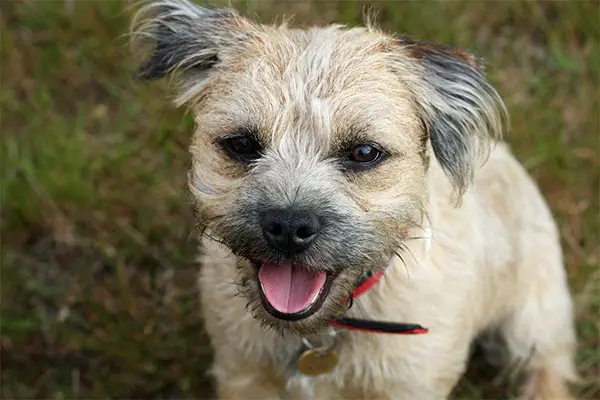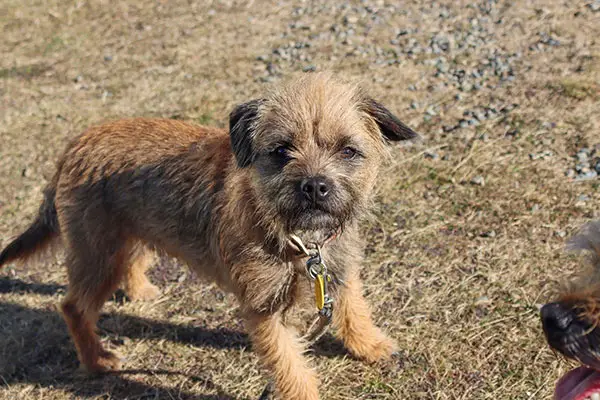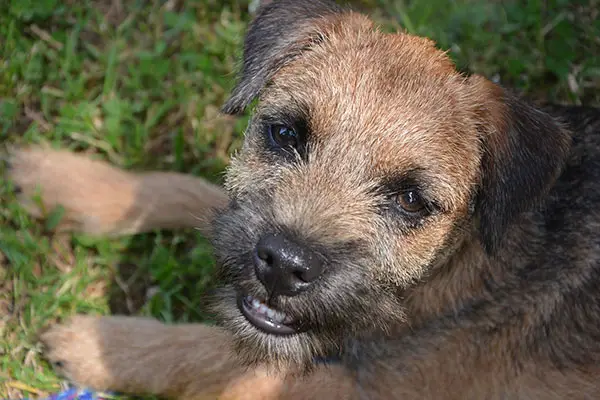Border Terriers are small-sized dogs known for their impressive hunting skills. Their bodies are covered with a wiry weatherproof coat that comes in grizzle and tan, blue and tan, wheaten, or red. The most distinct feature of the Border Terrier is its otter head – moderately broad and flat skull, and there’s plenty of space between the eyes and ears.
His hunting skills combined with his terrier energy already says a lot on how this breed is not compatible with everyone, especially first-time dog owners. These dogs love playing so much that they are the best fit for active families who can give them lots of attention and love. In return, the Borders will make you laugh.

Border Terrier Breed Statistics
| Dog Breed Group | Terrier |
| Breed Size | Small |
| Height | 12-15 inches |
| Weight | 13-15.5 pounds (male); 11.5-14 pounds (female) |
| Lifespan | 12-15 years |
Border Terrier Breed Ratings
| Energy level | |
| Exercise needs | |
| Requires attention | |
| Playfulness | |
| Trainability | |
| Shedding | |
| Grooming | |
| Friendly with family | |
| Friendly with kids | |
| Friendly with strangers | |
| Friendly with other dogs | |
| Prey Drive |
Border Terrier History
Border Terriers originated in 18th century England. It was believed to have been developed on both sides of the Cheviot Hills in Great Britain. This is a border between England and Scotland.
During these times, farmers of the land had big problems with hill foxes that terrorized their stock. So, they built the Borders with a long, narrow, and flexible body to make it easier for them to flush out foxes from their hiding places. The legs were also made long so they can follow horses during the fox hunting.
Borders are thought to be one of the oldest terriers in Great Britain. They are seen in many paintings, and the earliest one was made in 1754 by Arthur Wentworth. These dogs went in many names – Reed Water Terrier, Ullswater Terrier, and Coquetdale Terrier.
For years, Borders were only famous in England’s border country. Anyone outside knows very little about them until the early 20th century. By 1920, the breed was recognized by England’s Kennel Club, and ten years later, the United States registered their first Border Terrier.
Now, Borders rank 88th as the most popular dog breed among US families and remain to be active and lovable members of the family.

Border Terrier Temperament
Border Terriers are often described as affectionate, happy, and spirited dogs. Just like with other terrier breeds, Borders have high energies and certainly love running around. But unlike most terriers, these dogs are mild-mannered inside their homes.
Borders need to be included in family activities. They need to feel loved and be given enough attention. If left bored or without any outlet where he can expel his excess energy, this dog can be destructive.
If you’re looking for a playmate for your kids, Borders is also a great choice. Just make sure to always keep them supervised. They can also work and live peacefully with other dogs, but there are times where their instinct to chase kicks in.
Early socialization will help control their hunting instincts. This will also help make them more well-rounded dogs. If you’re looking for a guard dog, Borders may not be the dog for you. These dogs work well as watchdogs, and they can be friendly with strangers once introduced.
Training is a little bit challenging, but if treated nicely, they will respond well. Motivate them with food and a lot of praise. They are sensitive to correction, so make sure not to talk to them harshly.
Border Terrier Care Requirements
- Nutrition: Border Terriers don’t have any special diet requirements. As long as you provide them with a high-quality and well-balanced meal, this would be enough to support their energy and muscle support. If you’re feeding your dog a home-cooked meal, make sure that you only buy high-quality animal meat, fish and chicken oils, whole grains, fruits, and vegetables. All these are excellent sources of proteins, fats, carbohydrates, and vitamins. If you’re choosing dog food, it’s best to choose the premium quality ones only. These mustn’t contain fillers and additives that may be harmful to your dog. Ask your vet for some nutritional advice, so you only serve the best to your Border Terrier. Watch out for calorie intake, too, as small dogs are easy to overfeed.
- Grooming: Border Terriers have wiry double coats that shed occasionally. But, weekly brushing is needed to keep them in shape and free from tangles and mats. During the shedding season, you might need to brush it frequently is you don’t want dead hair all over your house. Baths can be given occasionally. These dogs don’t easily catch dog odor, so only give them baths when necessary. The ears, however, should be checked and cleaned regularly to avoid ear infection. Nails should be kept short too to avoid pain and discomfort to your Border Terrier.
- Exercise: Border Terriers are active dogs that need their daily exercise. Activities don’t have to be strenuous, as this can lead to overtiredness of your dog. Long walks or play sessions should suffice for this dog breed. Just make sure that you keep them on-leash or have a secured and high fence where they can run around. If you want a more active activity, you can let them participate in canine sports so they would be able to showcase their skills. Any activity that you both can do together would make your Border Terrier happy.
- Health: Like any other dog breeds, Border Terriers are prone to several health conditions. It’s essential to know these so you would be able to prevent it. Hip dysplasia and patellar luxation are problems on the bones and joints that your dogs can experience. This is why it’s essential to give them enough exercise. Malocclusions, seizures, heart defects, hypothyroidism, and cryptorchidism are other diseases you should watch out for. You can see one of your dog’s parents to check any existing disease that your dog may inherit. Screening tests are also available to detect other health conditions early, so it’s best if your dog takes one.
- Lifespan: The life expectancy of Border Terriers is 12-15 years.
Famous Border Terriers
- Netherbyers Ricky: The first Border Terrier registered in the US
- Puffy: The Border Terrier from the movie, “There’s Something About Mary”
- Baxter: The Border dog from the movie “Anchorman: The Legend of Ron Burgandy”
Fun Facts about Border Terriers
- Border Terriers originated in Cheviot Hills in the 18th century.
- These dogs are believed to have been developed by the Robson family in Northumberland.
- They were developed to hunt foxes, rabbits, groundhogs, raccoons, and possums.
- They were also called “Coquetdale Terrier.”
- The coat comes in various colors, which include red, wheaten, grizzle and tan, or blue and tan.
- They were recognized by the American Kennel Club in 1930.
Check Out Other Terrier Dog Breeds:
Airedale Terrier, American Hairless Terrier, American Staffordshire Terrier, Australian Terrier, Bedlington Terrier, Bull Terrier, Cairn Terrier, Cesky Terrier, Dandie Dinmont Terriers, Glen of Imaal Terriers, Irish Terrier, Kerry Blue Terrier, Lakeland Terrier, Manchester Terrier, Miniature Bull Terrier, Miniature Schnauzer, Norfolk Terrier, Norwich Terrier, Parson Russell Terrier, Rat Terrier, Russell Terrier, Scottish Terrier, Sealyham Terriers, Skye Terrier, Smooth Fox Terrier, Soft Coated Wheaten Terrier, Staffordshire Bull Terrier, Welsh Terrier, West Highland White Terrier, Wire Fox Terrier

